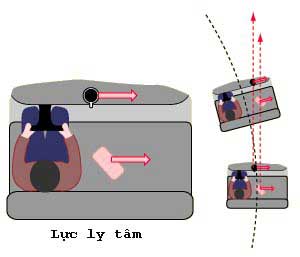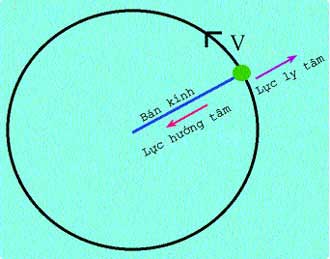Danger from curves
The quality of roads is upgraded day by day but few people are interested in adjusting the curves to limit the influence of centrifugal force. This is the cause of "mysterious" accidents.

Centrifugal force makes objects on vehicles move in the opposite direction.( Photo: Hyperphysics )
It is possible to provide the regular curve of the accident due to centrifugal force. Firstly, it is a curve from Thai Binh city to Diem Dien town. There was a time when there were 20 accidents on the same road: a motorbike and a car were pushed to one side of the road, hit trees or pushed down to the fields, causing damage to vehicles and death to the people. driver and passenger.
The curve of the curve on Lang Co Pass is also in that condition, the radius of curvature remains unchanged, but the journey time is encouraged to decrease gradually so that the speed of the train increases, and there are no warnings and speed restrictions. Specific levels, details, accidents are unavoidable.
The most special is probably the Phap Van - Cau Gie, which often happens with unusual accidents. Some say that the cause of geomagnetism causes. However, according to Dr. Ha Duyen Chau, Deputy Director of the Institute of Geophysics, it is difficult to affirm that, because only magnetic storms occur with strong intensity affecting human health. Mr. Chau said: "On the road from Phap Van - Cau Gie, if there are problems from the school, it is only anomalies from the school, not related to safe driving."

The components of centrifugal force.( Photo: Apollo )
The anomalous accidents on Phap Van - Cau Gie road are caused by centrifugal force. The main reason is that the road base is unstable and subsidence makes the surface of the road be raised, concave and not flat. Even more dangerous is the rising and falling concave. Standing on the side of the road, looking along the route is easy to spot these kinds of roads. Cars or motorbikes running at high speeds on such roads will create centrifugal force that stands and impacts the vehicle. When the car goes from the rainbow section to the concave section, the weight of the vehicle is suddenly becoming very heavy, as if we stuffed the ball, making the car become uncertain, shaking and steering to the horizontal. This process is repeated several times in a row, the accident is understandable.
Below is a way to calculate the specific centrifugal force, which arises when the vehicle runs on the curve. There are two types of curves: curved on the ground and curved on the vertical plane. In these two types of curves, though the centrifugal force is one, the direction of force compared to the horizontal plane is different.
The curve on the horizontal plane
When the vehicle runs on the curve, there will appear a centrifugal force with the starting point as the center of the car, the horizontal direction, the direction from the center of the curve outward. The magnitude of the centrifugal force is equal to the vehicle mass multiplied by the square of the velocity and divided by the curve radius of the road segment.

Figure depicts centrifugal force when entering the curve.( Muextension )
Center of Gravity: Focus
Tires becomes pivot points: Tires become stress points
Centrifugal force: Centrifugal force
Direction of turn: Driving directions
For example, a vehicle with a weight of 5,000 kg runs on a curve with a radius of 50 m. The speed of the vehicle is 50 km / h, ie 13.89 m / s, squared up to 192.9 (m / s) 2. The centrifugal force would then be 19,290 N, pushing into the center of the car in a horizontal direction, in the direction from the center of the curve facing out. In addition to centrifugal force, the vehicle also has gravity. Gravity is equal to the vehicle mass multiplied by the gravitational acceleration (g = 10 m / s2). Centrifugal force and gravity form a force.
This synergy also comes from the center of the vehicle pulling down in an inclined direction, the point touching the road surface will have a distance to the heart of the base surface by the height of the center of gravity on the road surface multiplied by the ratio of centrifugal force. with vehicle gravity. As in the above example, the ratio of centrifugal force to vehicle gravity is 0.39, if the center of gravity is 1.5 m higher than the road surface, the distance from the point touching the road surface of the force to the base of the base is 0.585 m. In this case, if the base of the car base is less than twice the above distance, ie less than 1.17 m, the vehicle will fall towards the center of the curve. The width of the car base is the distance between the outside surfaces of the wheel.
In this case, if the vehicle runs at 80 km / h, ie 22.22 m / s, the centrifugal force will nearly double and equal to 49,372 N. The road surface touch of the force will be separated from the heart. car base plate 1.5 m. If the width of the vehicle is less than 3 m, the vehicle will fall.
Thus, there are four weaknesses that can affect the flip of the car. First, the higher the speed, the more dangerous it is, as seen in the example above, the vehicle speed increased by 60%, centrifugal force increased by 160%. Second, the smaller the radius of curvature the smaller the disadvantage. Third, the heavier the car, the higher the rank, the more dangerous it is, because the car's center of gravity is higher than the road surface. Finally, the narrower the width of the car, the easier it is to fall.
This explains the accident of dumping E1, because although the radius of curvature of the railway is usually not less than 100 m, but the distance between the two rails is that the width of the base is narrow, usually no more than 1.2 m, so the force of gravity and centrifugal force are easily pulled out of the base, causing the ship to fall. Therefore, in the track section with a radius of 100 m, it is often necessary to limit the speed to less than 60 km / h. If running more than 60 km / h, the accident is inevitable.
The curve in vertical plane:
This is a segment with a straight line on the ground, but it is raised or concave, in this case the centrifugal force is still calculated as above and comes from the center of the vehicle, but vertically, from the bottom to the top If the curve rises. And the direction from top to bottom, if the curve is concave.
For example, the vehicle has a mass of 5,000 kg, runs at a speed of 60 km / h on a curve in a vertical, rainbow-up plane, with a radius of 50 m. In this case, the centrifugal force is 27,750 N, but vertically from bottom to top. Vehicle weight is still calculated as above by 50,000 N. Due to the centrifugal force and the gravity of the opposite direction, the vehicle gravity is 22,250 N, which means the car is lighter than half, the car will have the same phenomenon as traveling on slippery roads, ghost coefficient close to half too small, easy to slide sideways due to the sudden sudden steering wheel. In this case, if the vehicle runs at a speed of 80 km / h, the centrifugal force will equal 49,327 N, which is approximately equal to gravity. At this time, most of the vehicles do not cling to the road anymore, like being lifted up, the steering wheel is ineffective and the car is completely unstable, being pushed to the horizontal inertia.
Assoc. Dr. Nguyen Duy Hanh
- The hot sun curves the railroad in England
- Why is red related to danger? Explain you never heard of it before
- Sky bird - unpredictable danger for aviation
- Post-camel poem
- The largest (and most exotic) seed in the world
- What shaped pebbles?
- Why do hounds run faster than people?
- Kisses can put you in danger
- Beautiful O2 XDA Atom
- Danger from computer mouse
- WiBro is in danger
- Warning of risks from X-rays, magnetic resonance
 'Fine laughs' - Scary and painful torture in ancient times
'Fine laughs' - Scary and painful torture in ancient times The sequence of numbers 142857 of the Egyptian pyramids is known as the strangest number in the world - Why?
The sequence of numbers 142857 of the Egyptian pyramids is known as the strangest number in the world - Why? History of the iron
History of the iron What is alum?
What is alum? Which animal has the strongest bite in the world?
Which animal has the strongest bite in the world?  The Most Mysterious Force in Physics: The Nature and Origin of Gravity!
The Most Mysterious Force in Physics: The Nature and Origin of Gravity!  The US Air Force releases the first official photos of the 'stealth super plane' B-21!
The US Air Force releases the first official photos of the 'stealth super plane' B-21!  The mysterious phenomenon of suddenly getting old and young again in pilots
The mysterious phenomenon of suddenly getting old and young again in pilots  X-37B: Compact spaceship with outstanding US capabilities
X-37B: Compact spaceship with outstanding US capabilities  The US Air Force is about to start a dogfight with AI
The US Air Force is about to start a dogfight with AI 